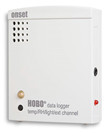Abstract
The indoor environmental quality of a library greatly affects the comfort and productivity of its users while preserving the materials. Despite the high energy consumption of HVACs in libraries, achieving acceptable thermal conditions, acceptable acoustics, and sufficient daylight levels for users remains a challenge. There are limited studies on the IEQ of educational buildings, especially regarding the current situation of libraries. It is important to conduct further studies to define design guidelines promoting indoor environmental conditions. The main objectives of this study were to investigate the IEQ of a campus library to recommend retrofitting strategies. The IEQ parameters in the rare collection room, which houses special collections, and in the library hall were assessed using a full-scale measurement, with eight HOBO data loggers and sensors deployed in various locations to monitor IEQ. A comparison of the results with the standards revealed that rare collection room was unsuitable for maintaining rare collections, as the average indoor air temperature exceeded 21.2 °C, which is beyond the threshold limit. Additionally, the relative humidity ranged from 51.3% to 55.8%, which is marginally high. To provide acceptable indoor conditions, this study recommends retrofitting strategies for the exterior walls, such as using cement plaster with a low thermal conductivity. In the library hall, the reading zone was found to be thermally uncomfortable. The air velocity was below the range of 0.15 ms−1 to 0.50 ms−1 recommended by MS 1525. The average CO2 level was 479.5 ppm, with some points registering an increase of up to 588 ppm. The noise level in the library hall ranged between 43 dB(A) and 61 dB(A), while the light intensity was below 300 lux in the reading area, which is not within the acceptable range. This study suggests improvement solutions, such as implementing an air temperature between 24.5 and 26.5 °C for higher thermal comfort and increasing the window-to-wall ratio to utilize natural daylight. These findings provide insights into the design of new libraries and the renovation of existing ones, ensuring that libraries continue to serve as vibrant centers of knowledge and learning for generations to come.
1. Introduction
The construction of buildings and their operation contribute to a large proportion of total end-use energy worldwide [1,2]. Masoso and Grobler [3] indicated that buildings consume 40% of primary energy, where the energy is required to generate, transmit, and distribute electricity, as well as being directly consumed on site. Studies show that, in the United States and the United Kingdom, a high portion of the consumed energy [4,5] is dedicated to achieving a comfortable indoor environment. In comparison to residential and official buildings, public buildings use more energy to maintain an acceptable indoor environment [6]. In particular, in hot and humid climates, the main energy consumers are air-conditioning (AC) and space-dehumidifying systems, which are utilized to provide a comfortable environment in buildings [7]. For instance, educational buildings and academic libraries with relatively straightforward functions consume a substantial amount of fossil fuel energy due to there being several users at different times of the day [8]. Moreover, more than 60% of the energy consumed in educational buildings belongs to the cooling, heating, and lighting systems. In an educational center, such as a university campus, libraries consume relatively higher energy than any other building to provide a comfortable indoor environment. For instance, the heating, ventilation, and air-conditioning (HVAC) systems, as well as the lighting, in the library at Pibulsongkram Rajabhat University accounted for around 81.49%, 10.89%, and 7.62%, respectively [9,10]. In another study conducted in the Tunku Tun Aminah Library, 25% of the energy consumed was allocated to lighting and electrical equipment, whereas the share of the AC system was 75% of the total end-use energy due to its role in delivering a comfortable indoor environment [11].
Although a large portion of the energy is used for HVAC systems in educational buildings, the presence of acceptable thermal conditions, acceptable acoustics, and sufficient daylight levels is still questionable. Particularly in libraries, providing a sufficient indoor environmental quality (IEQ) depends on various factors related to humans and objects such as books. Moreover, tropical regions are well known for their high temperatures and relative humidity, which can pose a serious threat to libraries and archival collections. The indoor environment variables must be effectively controlled to prevent materials from deteriorating. The impact of unacceptable temperature and humidity levels is significant and can cause chemical reactions that accelerate deterioration. For instance, a 10 °C temperature increase doubles the rate of most chemical reactions, including deterioration. A high relative humidity can also promote harmful chemical reactions in materials and encourage mold growth and insect activity when combined with high temperatures. In contrast, an extremely low relative humidity, which often occurs during winter in buildings with central heating, can cause the desiccation and embrittlement of some materials [12]. Design criteria, including layout concepts, IEQ design, and climatic considerations, play an important role in controlling energy consumption in high-performance buildings. Although new technologies and advances in building science offer an appropriate basis for architects and engineers to design high-performance buildings, there are still challenges to improving occupants’ indoor environmental satisfaction. In a study in China, the results indicated that contemporary libraries consume more energy to provide an IEQ better than that of old ones [13]. The main reasons for this are reported to be the presence of huge spaces in buildings, the dependency on artificial lighting instead of natural lighting, and the application of mechanical ventilation instead of natural ventilation [13].
Indoor environment variables, including the temperature, relative humidity, air velocity, illuminance, and acoustic level, are among the main IEQ factors affecting occupants’ health and comfort [14]. In a study of American higher education classrooms, Yang et al. [15] found that artificial lighting harms students’ satisfaction but does not affect their academic performance. However, unacceptable acoustic levels reduce students’ satisfaction and productivity [14]. Thus, an appropriate indoor environment is essential to maintain students’ health and promote their learning, and this is particularly true for campus public facilities [16,17,18].
Several studies have examined IEQ factors in library settings, with varying results. One study conducted in Nigeria assessed IEQ factors in three different libraries and found that all buildings had a poor IEQ when compared to guidelines such as the Chartered Institution of Building Services Engineers (CIBSE) guide [19]. Another study, conducted in a tropical climate, assessed the IEQ of free spaces in a library. The study found a lack of illuminance in corners, high levels of dissatisfaction with noise, and a high concentration of dust particulate [20]. These findings suggest a need for improved IEQ measures in libraries in tropical climates. A study at the University of Alberta investigated the impacts of occupant gender ratios on the IEQ of a library. The results indicated a need for the expansion of HVAC feedback control systems to reduce energy consumption [21]. These studies highlight the importance of assessing and improving IEQ factors in library settings, particularly in terms of lighting, noise, and air quality, to ensure the comfort and well-being of library users.
In addition to educational buildings, IEQ is important for all kinds of buildings. A study in Malaysia evaluated the IEQ of office buildings to identify occupants’ satisfaction. The results showed that the main sources of dissatisfaction were recognized as overcooling around 24 °C, a high relative humidity (RH) around 70%, glare, and background noise around 51.9 dB. The same study also stated that occupants’ dissatisfaction can influence their productivity [22]. In another study, it was shown that exposure to daylight significantly affects both productivity and mental health [23,24]; later, this effect was related to the circadian rhythm of humans [25].
This study represents a novel approach to analyzing the IAQ of a library by linking occupants’ comfort with material preservation conditions. There is a lack of literature examining both the environmental satisfaction of library occupants and the preservation of rare collections simultaneously. Additionally, previous studies have not focused on in situ measurements of IAQ conditions to recommend design guidelines, particularly in libraries. The collected data will enable the prediction of thermal conditions for library users and allow for a comprehensive assessment of the indoor environment for both occupant comfort and material preservation. Moreover, previous studies have demonstrated high levels of dissatisfaction with IEQ, yet no retrofitting strategies or passive design guidelines have been presented to address these issues in libraries. By incorporating the results of this study, we can recommend design guidelines and retrofitting strategies to promote better IEQ and overall occupant satisfaction in libraries. Ultimately, this will enhance the experience of library users and ensure the preservation of valuable materials for years to come.
Evaluating the IAQ of an operational library is believed to provide architects and designers with fresh perspectives on designing strategies that can improve indoor conditions. This study emphasizes the importance of understanding the factors that affect occupant comfort and satisfaction in a library’s indoor environment. Thus, the primary objective of this research is to evaluate the current indoor environmental conditions of campus library located in Kuala Lumpur, Malaysia. The aim is to provide design guidelines for retrofitting purposes that can improve the indoor environmental conditions of the library. The data required for this analysis were collected through full-scale measurements of various variables, such as the indoor air temperature, relative humidity, air velocity, indoor air quality, light intensity, and noise level.
This research is crucial, as it emphasizes the importance of providing an optimal indoor environment in libraries, which can improve learning outcomes, increase library usage, and contribute to the preservation of valuable collections. The results of this study can be used to promote sustainable design strategies that can be applied to other libraries and buildings, thereby improving indoor environmental conditions globally.
1.1. Guidelines
The preservation of artifacts and valuable books requires adequate indoor environmental conditions in museums, libraries, and archives [26]. A library hosts more than normal books; it also houses special collections (rare books or special books), workshops, study rooms, and social meetings. Thus, it should respond to all changing conditions and be creative, flexible, pleasant, and appealing to suit a range of users and books [7].
RH and temperature (T) are reported to be the two main contributors to the accelerated degradation of artifacts in museums [27]. This has resulted in the development of guidelines for sensitive indoor environments, such as museums, libraries, and archives [28,29,30,31]. Taking the ASHRAE standard as an example, different chapters are provided for museums, galleries, archives, and libraries, with detailed design requirements to address various indoor climatic classes. These climatic classes include requirements for transient fluctuations, seasonal changes, and the limits of T and RH. The climate classes, which range from class AA (precise control) to class D (limited control), serve as a general framework [32].
Although there are many indoor climate recommendations for artifact preservation, many cultural institutions use a strict indoor climate class, such as ASHRAE class AA, which results in a high energy consumption and the frequent maintenance of technical and mechanical components, resulting in expensive costs [2]. Table 1 presents a summary of the IEQ variables defined in different guidelines for the preservation of objects and human comfort in libraries. As shown in Table 1, there is a lack of a standard to comprehensively cover all IEQ variables.

Table 1.
Standards and guidelines for acceptable IEQ of libraries.
1.2. Retrofitting Strategies
Controlling temperature and humidity inside a building has a significant effect on architecture, comfort, sustainability, and preservation [46]. Retrofitting existing buildings is a way to lower annual energy consumption and improve IEQ with a cost-effective and widely adopted solution. This is considered one of the main approaches in built environments to achieve sustainability at a relatively low cost and high uptake rates. However, it should be noted that the methods used to identify the most cost-effective retrofit measures for particular projects still pose a major technical challenge [47].
Several countries have adopted strategies to incorporate modern technology to reduce their environmental, economic, and social impacts and to facilitate building refurbishment [48]. In terms of environmental sustainability, several retrofitting strategies for better indoor conditions in hot and humid regions are available. Building orientation is a key factor in the design stage that affects indoor thermal conditions [49]. If neglected, other retrofitting techniques must be implemented to control solar radiation, natural daylight, and ventilation. Effective techniques for tropical climates include using plants for shading, preventing heat storage, using reflective external surfaces, and increasing ventilation through large openings and vented double roofs [50,51]. Additionally, using insulated building materials, using lightweight construction (especially for buildings in a tropical climate), implementing shading devices for glazed areas, adjusting the window-to-wall ratio (WWR), and redesigning internal layouts can improve indoor conditions [52,53]. Regarding libraries, refurbishing and controlling building form configurations can also lead to comfortable indoor environments [54].
Studies on lighting retrofitting strategies are limited globally. In Italy, an ancient library in a historical building used a decomposition approach to control illuminance levels based on different occupant activities and visual tasks in various use areas [55]. Upgrading an artificial lighting system to an energy-efficient one is a less extensive retrofit that can be used when resources are limited or a single condition needs improvement [43]. For example, using LED technology and the smart grid concept in a library’s lighting retrofit resulted in a reduction in energy consumption of 54% (savings of 427 MWh/year) [56]. To achieve the highest energy efficiency in lighting projects, natural and artificial lighting must be combined, as they are influenced by the internal layout, facades, and solar direction. If natural light does not generate additional heat, resulting in an extra cooling demand, it can reduce energy use [57]. The factors that affect daylight levels include geographical location, sky conditions, solar orientation, exterior features, window frame size and arrangement, shutters, louvers, and interior surface reflectivity [58].
Regarding acoustic quality, Alonso et al. [59] assessed regulations and compared techniques for improving sound insulation. The study concluded that there is a lack of a global consensus on acoustic requirements, and installing external sound insulation in building facades is an effective strategy. Recommendations for suitable window construction systems were provided to control noise penetration. Another study simulated the effects of various window dimensions and absorber parameters to evaluate the sound insulation performance of ventilation windows and proposed guidelines for design engineers [60]. In Hong Kong, a study examined a new ventilated window design combining multiple quarter-wave resonators and wing walls to balance the acoustic and ventilation performance of buildings. This new design was considered a novel retrofitting strategy, as traditional windows could not control the noise in buildings near busy roads. The results showed a significant noise reduction (a 10–22 dB transmission loss) [61].
2. Materials and Methods
2.1. Case Study
The case study is in Kuala Lumpur, Malaysia, 3.1569° N, 101.7123° E. The campus library, which is located at a university, houses a collection of published and unpublished materials, with a particular emphasis on the Malay language, literature, and culture. To ensure preservation, the materials are stored in closed stacks, but designated reading areas are available for users to access reference facilities. Monographs, conference papers, official publications, manuscripts, and personal collections are all materials housed in the library. Moreover, the library consists of reading zones, including free zones, and individual and group study areas. Figure 1 shows the location of the building on the university campus and a bird’s-eye view of the surrounding buildings. The building has a north–south axis, and many surfaces of the façade are in the east and west elevations. Thus, the building receives a high amount of solar radiation and heat on the east and west surfaces.
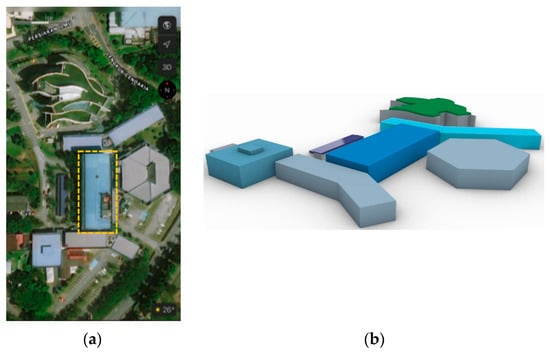
Figure 1.
(a) Library location on campus and (b) bird’s-eye view of surroundings.
The sun’s radiation at the summer solar solstice is illustrated in Figure 2. As shown, although the library is surrounded by other buildings and partially covered by their shadows, high radiation is received in the east and west elevations. This condition increases the cooling load of the building and brings unsatisfactory thermal conditions for the occupants. It is important to consider the surrounding environment and shading strategies when designing a building to ensure optimal thermal performance and comfort for users.
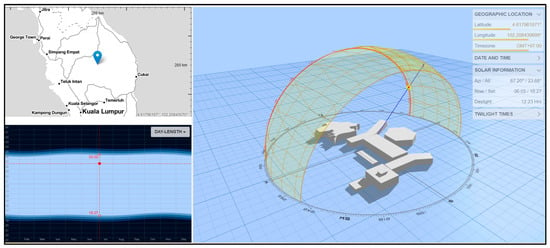
Figure 2.
The high amount of solar radiation from the east and west elevations.
2.2. Meteorological Data
Kuala Lumpur has a tropical rainforest climate according to the Köppen climate classification [62], which is characterized by a high humidity and abundant rainfall throughout the year. Ten years of microclimate data were collected from the nearest meteorological station, Petaling Jaya meteorological department. As shown in Figure 3, the temperature tends to remain around 27–28 °C. The data show that the monthly average temperature is at its highest in May and June. Additionally, the high relative humidity, ranging between 74.4% and 81.3%, can also contribute to indoor air quality issues, such as mold growth, which may affect the health and comfort of library patrons and staff. The hot and humid climate throughout the year highlights the importance of proper ventilation and cooling systems in the library. Thus, it is crucial to consider these factors when designing or retrofitting the library building to ensure a comfortable and healthy indoor environment.

Figure 3.
Mean air temperature and relative humidity for ten years.
2.3. Measurement Equipment
Table 2 lists the instruments and equipment used to monitor indoor conditions during the full-scale measurement. The indoor air temperature, relative humidity, and air velocity were measured using calibrated HOBO U12 data loggers and an external air velocity sensor. The indoor noise, measured as the sound pressure level (SPL), and air quality were measured using Pulsar and Yes Air, respectively.

Table 2.
Data loggers’ specifications.
Supplementary Equipment
Aluminum poles with a 0.03 m diameter and clamps were designed to hold the HOBO U12 data loggers and the three air velocity sensors (T-DCI-F900-S-O), which were distributed horizontally and vertically in the library. The aluminum pole was assembled with a rounded base (0.3 m diameter) with three wheels for greater stability and mobility (see Figure 4). The rounded base provided enough space for the battery used by the air velocity sensor. The aluminum poles stood at the center of the aluminum bases. Each pole was long enough to support four clamps. Each clamp secured one data logger. There were two clamps installed 1.1 m above the ground to hold the data logger and air velocity sensors. Two more clamps were installed at 0.2 and 1.8 m above the ground to hold more data loggers. There was no installed air velocity sensor above the described heights due to the limited number of air velocity sensors. An experimental test was conducted in an area with few activities, such as reading, writing, or studying. Therefore, it was necessary to collect data 1.1 m above the ground in the library hall due to the head height of a seated person [63].
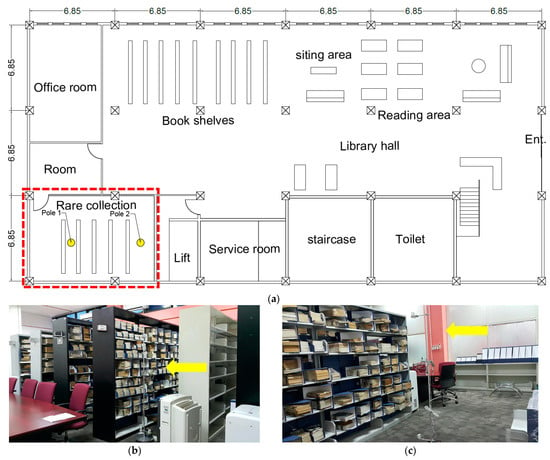
Figure 4.
(a) Library layout and data loggers installed on (b) pole 1 and (c) pole 2.
2.4. Experimental Layout for Measurement
The HOBO data loggers and air velocity sensors were set in the library hall and rare collections room to collect data on the indoor temperature, relative humidity, and air velocity. Figure 4a shows the locations of the poles in the layout plan within the special collections room. The room is specified with a dashed red rectangle. Moreover, the positions of the poles in the room are highlighted by yellow points. A total of six HOBO data loggers were distributed in the room for special collections to record the indoor air temperature and relative humidity at various levels. The air velocity sensors were installed 1.1 m above the ground. Each of the three data loggers was installed on a clamp, which was screwed on a pole, at heights of 0.2, 1.1, and 1.8 m above the ground. The condition of rare collections room was different from that of the library hall. The intensity of light and noise variation depends on the distance from the window. To monitor the effect of the intensity of the lights on the rare collection, several points were condensed. However, the distribution of conditioned air by the mechanical device was equal at all points of the room. It should be mentioned that the supply air temperature was constant during library operation. To prevent the collection of useless data for thermodynamic conditions, only two points were selected (Figure 4). The data loggers were installed horizontally, at least 0.8 m from the internal walls, to minimize the impact of the radiative temperature. To measure the light intensity and noise level in rare collections room (10 m × 6.9 m), 15 recording points were selected, as shown in Figure 5, arranged in a rectangular matrix with 1.2 m spacing for precise results.

Figure 5.
Design matrix for noise level and light intensity measurements in rare collections room.
In addition to rare collection room, this study conducted field measurements in the library hall to determine the environmental conditions, such as air temperature, relative humidity, air velocity, light intensity, and noise level. As shown in Figure 6, the library hall consists of different spaces, such as a reading area, bookshelves, a sitting area, and an entrance area; thus, multiple data loggers were placed to obtain accurate recordings. Six locations were selected for field measurements, as highlighted in Figure 7a.
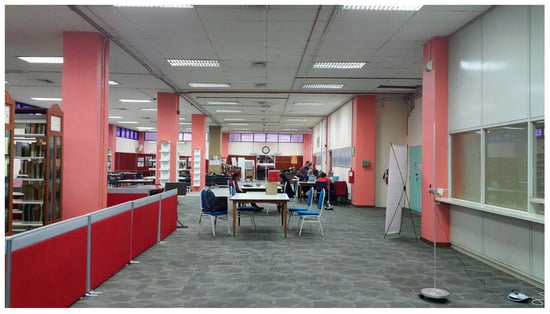
Figure 6.
Library hall, reading area, and bookshelves; view from the opposite entrance.

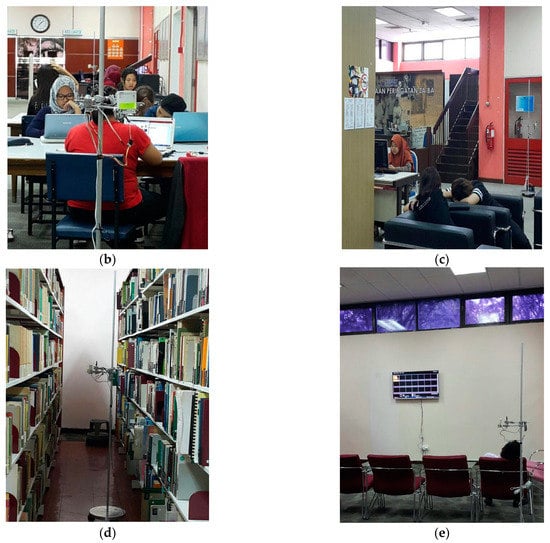
Figure 7.
(a) Library layout and (b–e) HOBO data logger and air velocity sensor.
Figure 7b–e depict the data loggers and sensors installed on the poles to measure the air temperature, humidity, and air velocity. They were positioned 1.1 m above the ground to capture the environmental conditions at head level, as many of the activities carried out in the library hall are sedentary activities. The data recorded by the air velocity sensor were directly transferred to the HOBO data logger and stored.
In addition to measuring the previously mentioned parameters, this study also measured the light intensity and noise levels in the library hall. To ensure accurate data collection, the layout of the library hall was divided into 40 rectangles, and the center points of these rectangles were chosen for measurement. Figure 8 illustrates the matrix used to record these parameters, as well as the zoning of the spaces. The distance between the measured points was approximately 3.5 m, the length of the room was 41.5 m, and the width was 20.5 m. The matrix design allowed for an evident analysis of the light intensity in each space. The layout of the building was also divided into six zones to analyze and discuss the noise level in each zone. Table 3 provides a clear description of the zones in the library hall and rare collection room. Through the zoning analysis, the minimum, maximum, and average values of the noise level were determined. The number of points for measurement varied based on the area of each zone. As most of the space was designated for reading, 14 points were selected for measurement. In zone 6, rare collection room, 15 points were selected for light intensity and noise level measurements.
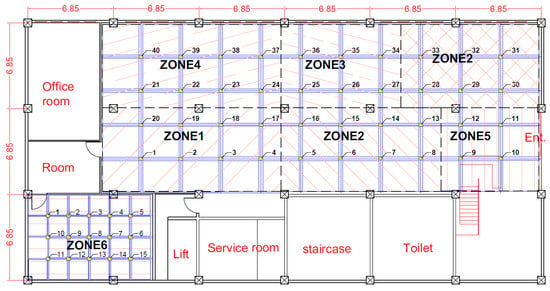
Figure 8.
Space distribution zoning and measurement matrix.

Table 3.
Zoning of layout plan for analysis of noise level.
The data collected by the data loggers and sensors were initially analyzed using HOBO pro software and finalized for further analysis. In the next step, the data were categorized, and the outliers were removed. A further quantitative analysis of the data was carried out using Microsoft Excel to compare the results with the standards and guidelines. The average, minimum, and maximum values for the measured parameters were calculated, and they are presented in several graphs to make a comparison with the threshold limits for the IEQ parameters. The x-axis of the graphs presents the location of the measurement and the average, minimum, and maximum values of the parameters, and the y-axis of the graphs shows the measured parameter and threshold limit.
2.5. Thermal Comfort Assessment
An indoor environment is considered thermally comfortable when at least 80% of the occupants report being comfortable with the thermal conditions [64]. Different mathematical methods have been proposed for the evaluation and prediction of thermal comfort, such as computational fluid dynamics (CFD) simulation [65,66] and Fanger’s model [67,68]. Fanger’s model [64] is considered to predict thermal comfort for the selected case study. This model is suitable for indoor air-conditioned environments, whereas the adaptive model is suggested for naturally ventilated environments [69]. Fanger introduced the predicted mean vote (PMV) model to assess thermal comfort [70]. According to [70], the PMV index is calculated using Equation (1):
where L is the thermal load on the human body, and M is the metabolic rate. The thermal load, which is derived from the heat balance equation, is
where fcl is the clothing area factor, hc is the coefficient of convective heat transfer, Tcl is the surface temperature of the cloth, Ta is the air temperature, and Tr is the mean radiant temperature. Moreover, the body heat lost due to radiation, convection, evaporation, and respiration is considered in addition to the body heat generated from metabolism and activity.
The clothing area factor () is defined as the ratio of the clothed body surface to the nude body surface, which is correlated to the thermal resistance of the clothing [70]. Thus,
where the in clo is the clothing’s thermal resistance.
is calculated using Equation (4):
where is the free convective heat transfer, and is the forced convective heat transfer [70]. These two are calculated considering Equations (5) and (6):
and
Moreover, is calculated using Equation (7):
where is the ambient air vapor pressure and is calculated using Equation (8) [71]:
where the relative humidity is shown as RH.
3. Results and Discussion
This section presents an analysis of the data collected in special collection room and the library hall. A critical analysis of the data helps to determine the current condition of the spaces based on various indoor environmental parameters. The results of the analysis are compared with the standards to assess the compliance of the indoor environment with established norms. Overall, indoor environmental data in a conditioned space are not variable over time, and they are almost constant. The air temperature is the highest for all points at noon for all rooms. The relative humidity is the highest, especially in the early morning. The air velocity is almost constant, and it is up to 0.2 m/s for data loggers 3 to 6. The indoor air pollution and noise are exceeded when the library is full, from 2:00 pm to 5 pm. The lighting does not exceed the limited values, and the library always uses artificial lighting during operational hours.
3.1. Indoor Environmental Conditions
3.1.1. Special Collections Room
The indoor air temperature in rare collection room demonstrated a clear trend over the course of the measurement period, with fluctuations indicating changes in the ambient temperature and the HVAC system’s performance, as shown in Figure 9. This graph depicts the data collected by the six HOBO data loggers placed at different heights on poles 1 and 2. As the room was air-conditioned, the average air temperature in the room was found to be 21.2 °C to 21.7 °C and was constant across all locations. Based on the study by Ogden [12], the acceptable mean indoor air temperature in a room with valuable collections should be less than 21.1 °C. The standards suggest around 18 °C (see Table 2) [32,33]. Thus, the mean air temperature in rare collection room was slightly higher than that in the recommended guidelines and standards for objects. However, this finding can be compared with the findings in the literature on indoor air temperatures in buildings. According to [64], the recommended indoor air temperature range for thermal comfort in buildings is between 20 and 25 °C, with a target of around 22 °C. The average indoor air temperature of the library, as reported in this study, fell within this recommended range. It should be mentioned that the maximum air temperature variation was 3.8 °C, which was observed in data loggers 5 and 6. This variation is because the outdoor temperature variation influences the indoor air temperature, and although the supply air temperature was constant, this resulted in a min air temperature of 19 °C and a max temperature of 22.8 °C.
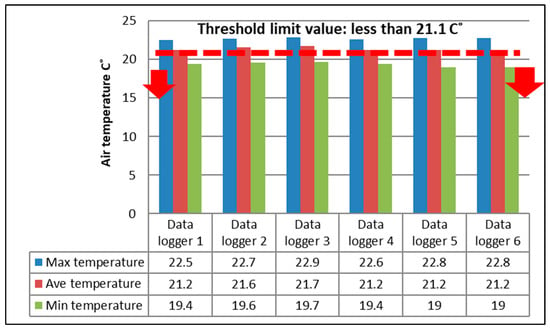
Figure 9.
Overall indoor air temperature in rare collection room.
It is important to note that the indoor air temperature is just one factor that affects thermal comfort. Other factors, such as air velocity, relative humidity, and radiant temperature, also play a role in determining thermal comfort, and this is discussed later in this study. It should be mentioned that rare collection room is used to store books, and there is no study space there; thus, having a thermally comfortable environment for occupants can be avoided in this room. In addition, the act of retrieving books from this room is short and temporary, and time is needed for the body to adjust to the new room temperature resulting in thermal sensation to be affected; thermal comfort depends on various factors, such as the difference between the body’s initial temperature and the temperature of the new room, age, metabolism, clothing, and overall health.
The average air temperature was the highest in data logger 3, which was installed 1.8 m above the ground on pole 1. This confirms that the indoor air temperature at the higher levels was slightly higher than that at the lower levels. A comparison of the mean air temperature between poles 1 and 2 confirmed that the back side of the measured room was slightly cooler than the front side. This was due to the presence of adequate indoor air velocity at the back side of the room.
Maintaining stable environmental conditions is crucial for preserving materials in libraries and archives. A study by Smedemark and Ryhl-Svendsen [72] revealed that higher temperatures in libraries result in an increased release of formic acid and acetic acid from papers in the air. This study concluded that reducing the air temperature lowers the off-gassing of organic acids from papers, resulting in a lower pollution concentration in the air. However, Kim, et al. [73] indicated that the impact of formaldehyde released from paper on the air quality of libraries is negligible. The emission of organic compounds from equipment and finishing materials, such as furniture, panels, and flooring, primarily affects the air quality of libraries. However, it is crucial to maintain a moderate and consistent temperature and a relative humidity level within the recommended range throughout the year to preserve libraries and archival collections. Therefore, institutions must ensure that the climate control system is never turned off, and settings should not be lowered, including on nights, weekends, or holidays, even if it may lead to additional expenses. However, these costs are expected to be significantly less than the costs of the conservation treatments required to repair the damage caused by fluctuations in temperature and relative humidity.
Although it may not be feasible for some libraries and archives to implement these recommendations due to financial constraints or other limitations, it has been proven through scientific testing and experience that maintaining moderate and stable levels of temperature and relative humidity significantly prolongs the lifespan of materials. Therefore, institutions should strive to achieve these conditions as much as possible within their means. Sahin, et al. [74] conducted a study to investigate the indoor microclimate of the Tire Necip Paşa Library in İzmir, Turkey, for the preventive conservation of manuscripts. The study analyzed factors such as temperature, relative humidity, and air velocity to determine the conditions within the library and to assess the potential impact on the preservation of manuscripts. The results showed that the conditions within the library were favorable for the preservation of manuscripts, although some improvements to the ventilation system were suggested to ensure consistent and stable conditions. This study also indicated that a lower temperature and RH can reduce the degradation of manuscripts. Thus, long-term collections and archives must be stored under low-temperature and low relative humidity conditions [75].
According to the ASHRAE Handbook–HVAC Applications [76] and a study by Ogden [12], the acceptable range of relative humidity in a room with special collections should be between 30% and 50%. The records show that, at times, the relative humidity dropped below 50% due to the air-conditioning system. To ensure the preservation of these valuable collections, it is important to have a well-designed room and an adequate air-conditioning system that always maintains a relative humidity of 30–50%. Although a substantial amount of energy was consumed to control the relative humidity in rare collection room, the results show that it was more than 50% for all measured points. Figure 10 presents the overall relative humidity for the measured room and the Threshold Limit Value (TLV). The average relative humidity in the room for special collections and manuscripts was between 51.3% and 55.8%, which is marginally high. Furthermore, a comparison between the relative humidity at poles 1 and 2 indicated that it was slightly higher at pole 2 located at the back of the room. Although the indoor air velocity at the backside of the room was higher than that at the front side, further dehumidification should be carried out to reduce the percentage of relative humidity in this room. Kupczak, et al. [77] explored the impact of paper and wooden collections on humidity stability and energy consumption in museums and libraries. The study found that these collections have a significant impact on the indoor environment, affecting both humidity stability and energy consumption. The authors recommend measures such as proper collection storage and the use of controlled ventilation systems to maintain stable indoor conditions and reduce energy consumption.
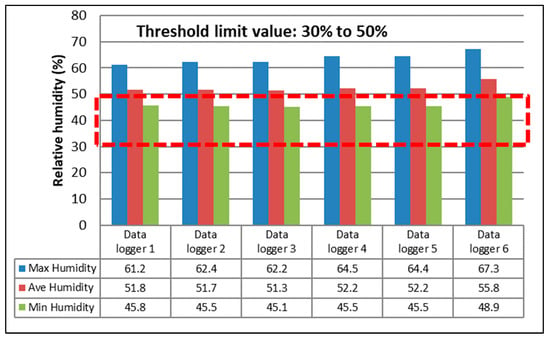
Figure 10.
Overall indoor relative humidity in rare collection room.
This effect can be even more critical in a tropical climate such as that of Malaysia with a very high relative humidity throughout the year. It is widely accepted in the preservation and conservation community that high relative humidity levels can be detrimental to the long-term preservation of rare books and manuscripts. This is because elevated humidity levels can promote the growth of mold and other fungi, as well as contribute to the breakdown of paper and other organic materials. Generally, relative humidity levels above 50% can lead to the growth of mold and other microorganisms, which can cause serious damage to paper and other organic materials. In addition, high relative humidity levels can also lead to an increased incidence of insect damage, as well as promote the breakdown of adhesives and other binding materials. Zou, et al. [78] indicated that elevated relative humidity levels led to an increased breakdown of cellulose, a key component of paper, as well as an increased risk of fungal growth. The authors concluded that relative humidity levels should be maintained at a consistent level and that levels above 50% should be avoided to minimize the risk of damage to paper and manuscripts. Thus, maintaining relative humidity levels below 50% is crucial for the preservation and long-term preservation of rare books and manuscripts.
In addition to the temperature and relative humidity, the indoor air velocity in rare collection room was measured. The results indicate that the average indoor air velocity at pole 2 was higher than that at pole 1, reaching a maximum of 0.48 m/s at 1.1 m above the ground, as shown in Figure 11. It should be noted that the average air velocity in rare collection room was not adequate to preserve rare and valuable collections, highlighting the need for proper climate control. Lechner [79] indicated that a higher air velocity can reduce the air temperature in space. A reduction in the effective temperature of 1.2 °C was observed as the air velocity increased from 0.2 to 1.0 ms−1 [80]. Moreover, regarding human thermal comfort, ASHRAE 55–2017 [64] highlights that the highest acceptable air velocity is 1.2 ms−1 due to the cooling effect of high air velocity, with air velocity less than 0.1 ms−1 being classified as still air. The air velocity should also be consistent and stable, with minimal fluctuations, to prevent damage to materials. It is important to note that the recommended air velocity for a library’s rare collection room may vary depending on the specific needs and conditions of the collection. Moreover, the recommended ventilation rate for libraries can vary based on different factors, such as the size of the space, the number of people using it, and the presence of any sources of pollution.
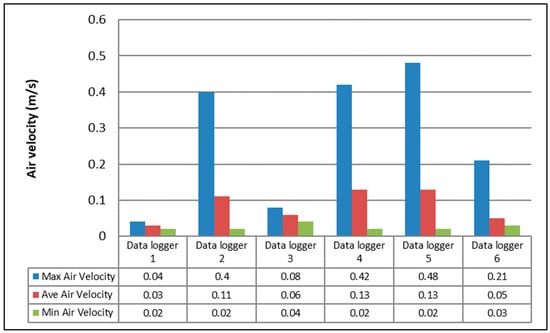
Figure 11.
Overall indoor air velocity in rare collection room.
Preserving archive materials while maintaining thermal comfort can be a challenging task, as conflicting conditions are often required. An adequate air velocity is crucial for the preservation of archive materials, as it helps to control the environment by preventing the buildup of harmful pollutants and maintaining consistent temperature and humidity levels. However, a high air velocity can lead to uncomfortable conditions for the people occupying the space, as it can cause rafts and decreased thermal comfort.
Balancing these two conflicting requirements can be difficult, and a solution must be found that takes into consideration both the preservation of the archives and the comfort of people. This can be achieved by carefully controlling the air velocity levels in the archive space, such as using air distribution systems that allow for adjustments based on need. Additionally, the use of air filtration systems to remove harmful pollutants from the air can help to minimize the need for high air velocity levels. While providing an adequate air velocity is crucial for preserving archive materials, it is also important to consider the thermal comfort of those who occupy the space. Finding a balance between the two is crucial and can be achieved through careful planning and the use of appropriate technologies.
Table 4 shows the recorded data, including the minimum, maximum, and average levels of CO2, TVOC, CH2O, and dust, in rare collection room. While the analysis of the indoor air quality of rare collection room showed that the levels of contaminants and pollutants were within acceptable limits, it is important to critically evaluate the results and consider their implications for the preservation of the special book collection. The average CO2 and TVOCs levels recorded in the room were 457 ppm (lower than the threshold of 1000 ppm) and 1.5 ppm, respectively. However, the acceptable levels of pollutants can vary depending on several factors, including the type of environment and the type of materials being stored.

Table 4.
Results of indoor air quality in rare collection room.
For special book collections, it is crucial to maintain stable and controlled indoor conditions to preserve the materials and prevent damage. This requires not only the monitoring of pollutant levels but also the implementation of measures to mitigate any negative impacts on the collection. For example, controlling the temperature and humidity levels in the room, using air filtration systems, and ensuring proper storage of the books are all important steps to take. While the analysis of the indoor air quality of rare collection room showed that the pollutant levels were within acceptable limits, it is important to continuously monitor and manage the indoor environment to ensure the preservation of the special book collection. A holistic approach that considers all factors affecting the indoor environment is crucial for the long-term preservation of these valuable materials.
3.1.2. Library Hall
The experimental results for 24 h in the library hall show that the mean air temperature was between 23.3 °C and 24.3 °C. As shown in Figure 12, the air temperature near poles 5 and 6 was slightly higher than that near the other poles. The main reason for this is because of the proximity of the mentioned poles to the entrance. According to the predicted mean vote (PMV) proposed by Fanger [81] and the comfort range in buildings proposed by Givoni [82], the indoor air temperature in the library hall was slightly cool. Thus, this may cause an uncomfortable environment for readers who are engaged in sedentary activities in the library. Furthermore, the building is not environmentally and economically sustainable, as huge amounts of energy are consumed for cooling annually.
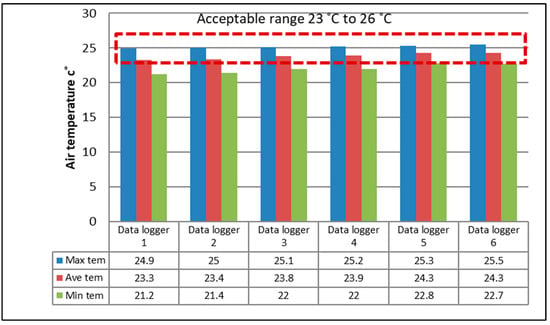
Figure 12.
Overall indoor air temperature in the library hall.
The indoor air temperature varies from 21.2 °C (data logger 1) to 25.5 °C (data logger 6). This variation is due to outdoor temperature variations and the internal gain. Although the supply air temperature is constant, the occupancy ratio influences the internal gain, as well as the outdoor conditions. Thus, a maximum variation of 4.3 °C can be observed in the library. This temperature variation of more than 4 °C can cause discomfort during certain hours. To achieve thermal comfort, the indoor air temperature should be maintained within a narrow range, minimizing variations.
As the library hall was equipped with a central air-conditioning system, the air velocity was almost constant for all the measured points. Figure 13 shows that the mean air velocity at 1.1 m above the ground (head level of a seated person) was only 0.05 ms−1, which was not tangible. The observed air velocity fell below the range of 0.15 ms−1 to 0.50 ms−1 recommended by MS 1525 [83]. The fluctuation of the air velocity was the lowest at pole 2, as it was between bookshelves. Thus, the air circulation was limited around the data logger at pole 2. According to the guidelines for air velocity in an indoor environment, the air ratio in the library hall was barely noticeable [79].
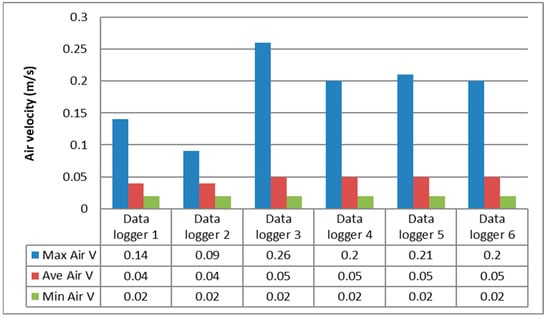
Figure 13.
Overall indoor air velocity at the library hall.
The range of the mean relative humidity was between 63% and 66%, which is comfortable for an air-conditioned room. According to MS 1525 [83], the recommended RH level should fall within the range of 50% to 70%. It is advised to maintain the RH level at 70% or below. Moreover, it may be considered that there was no requirement for dehumidification in the library hall, as there was no section for valuable manuscripts. Figure 14 presents the average, minimum, and maximum levels of relative humidity in the library hall. The maximum fluctuation of the relative humidity was 11.2% at pole 1, which was in the reading zone.
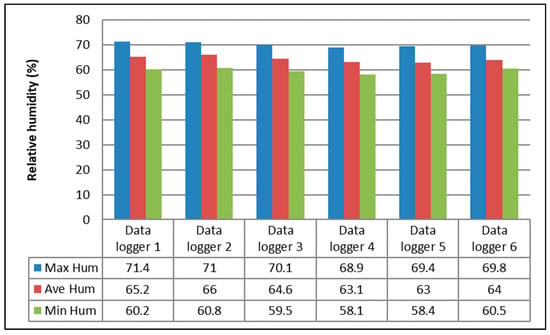
Figure 14.
Overall indoor relative humidity at the library hall.
The indoor air quality of the library hall was evaluated, and the results are shown in Table 5. The average level of CO2 was 479.5 ppm, and it increased up to 588 ppm. The TVOC was 0.52 ppm, which was less than that in rare collection room. With the same result, the amount of dust (mg/m3) in rare collection room was higher than that in the library hall. The reason for this may be due to there being more space in the hall. It is important to note that being exposed to a polluted indoor environment for an extended period can cause immediate adverse health effects, such as headaches, wheezing, lethargy, shortness of breath, skin irritation, throat irritation, and eye irritation [84]. Moreover, occupants exposed to poor IAQ in libraries or schools may experience symptoms of stress, decreased productivity, and impaired academic performance [85,86,87]. University libraries play a crucial role in providing access to academic resources, including books, journals, databases, and multimedia materials. However, they also serve as a hub for intellectual and social interactions, enabling students and researchers to engage in self-directed and collaborative learning activities. Through various programs and initiatives, university libraries promote critical thinking, research skills, and lifelong learning. They also provide spaces for study, research, and collaboration, equipped with state-of-the-art technologies, research tools, and resources. In this way, university libraries contribute to the academic success and personal growth of students and researchers. The indoor air quality of a university library is a crucial factor that should not be overlooked. With students potentially spending several hours a day in the library, the air that they breathe can have a significant impact on their health and academic performance. A library with a poor air quality can lead to symptoms such as headaches, lethargy, and eye irritation, which can negatively impact a student’s well-being and ability to learn. Universities need to prioritize the indoor air quality of their libraries, by implementing measures such as proper ventilation and air filtration, to ensure that students have a safe and healthy learning environment.

Table 5.
Results of indoor air quality of the library hall.
The results of the field measurement of the noise level in the library hall and rare collection room are presented in Figure 15. Generally, the noise levels, which were measured as the sound pressure level, in the different zones were similar. However, the noise level in rare collection room (zone 6) was higher than that in the other zones. The reason for this was that the air-conditioning systems created more noise in areas with limited space than in the quiet zones in the library. Besides rare collection room, the noise level at the entrance (zone 5) was higher than that in the other zones, with the noise being the lowest in zone 4 in the library. According to the results, the noise level in the library hall was between 43 dB(A) and 61 dB(A) depending on the number of users and their activities. However, the acceptable range for the library area is between 38 dB(A) to 48 dB(A) [88]. Thus, zones 5 and 6 were considered noisy environments. However, zones 1 to 4 were in the acceptable range, with the calm environment offering a comfortable environment for studying.
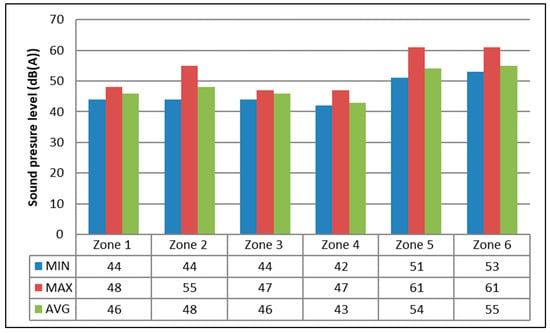
Figure 15.
The noise level in different zones of library hall.
The noise level in a library is an important factor to consider, as it can significantly impact a student’s ability to concentrate and learn. In a library, it is crucial to maintain a quiet and conducive environment where students can focus on their studies without any distractions. High noise levels can cause stress and fatigue, making it difficult for students to retain information and complete their work effectively. Moreover, libraries are not only a place for individual study but also for group work and collaboration, where students may need to have discussions and engage in other activities that may generate noise. In such cases, it is important to have designated areas within the library for group work and discussion, which are separate from the quiet study areas. Maintaining an appropriate noise level in a library is critical for the well-being and academic performance of students. Libraries should implement measures such as soundproofing and noise reduction strategies to create a peaceful and productive learning environment.
3.1.3. Light Quality
This study analyzed the light intensity in rare collection room and the library hall based on the measured data at selected points. Figure 16 shows a matrix where the intensity of the light is presented in gradient colors. As shown, the minimum light intensity (0–100 lux) was between the bookshelves in the library hall. However, the maximum light intensity (250–300 lux) was at the entrance and some parts of the reading zones.

Figure 16.
Light intensity in the library hall and special collection room.
It should be noted that the small tinted windows located near the ceiling are not able to transfer daylight into the library hall and rare collection room effectively. Thus, both spaces relied on artificial lighting to provide a comfortable environment for the occupants. As shown in Figure 16, the light intensity was less than 300 lux in the reading area. According to the guidelines, ASHRAE Standard 90.1 [89], and studies on the required amount of light in a reading zone, the range of the light intensity was not acceptable in the library [90,91]. Thus, the study recommends increasing the WWR to allow more natural light to penetrate the indoor environment. By designing buildings to respond to the environment bio-climatically, a further amount of energy can be saved. Furthermore, sufficient lighting can be provided for users, which helps them to increase their productivity.
The light intensity in a library is an important factor that directly impacts the learning environment and experience of students. Adequate lighting is crucial for creating a comfortable and visually appealing environment that fosters concentration and learning. A library’s lighting level should be sufficient to allow students to comfortably read, write, and study without straining their eyes. The acceptable light level in a library typically ranges from 500 to 700 lux. A lower light level can cause eye strain, fatigue, and decreased productivity, while a higher light level can cause glare and distractions.
It is also important to consider the type of lighting used in a library. Natural light is often preferred, as it provides a comfortable and natural light source. However, if natural light is not available, artificial lighting such as LED lights can be used. LED lights are energy-efficient, produce little heat, and emit a minimal glare. Thus, maintaining an appropriate light level in a library is essential for the well-being and academic performance of students. Libraries should aim to create a visually appealing and well-lit environment by implementing measures such as adequate lighting, appropriate lighting types, and glare control strategies. The acceptable light level in a library should be closely monitored and maintained within the range of 500 to 700 lux to provide students with a comfortable and productive learning environment.
3.2. Thermal Quality Improvement
As explained in Section 2.3, thermal comfort was predicted using Fanger’s PMV-PPD model for each zone due to the difference in space functionality. The clothing value was 0.57 clo because it was observed that many occupants wore trousers, short-sleeved shirts, socks, and shoes or slippers. The metabolic rate was considered to be 1 met for a seated person reading. Under moderate outdoor conditions, the difference between the indoor air temperature and the mean radiant temperature is negligible. Therefore, it is reasonable to assume that the mean radiant temperature is equal to the indoor air temperature [92,93,94].
To achieve a thermally comfortable indoor environment, ASHRAE Standard 55 [64] suggests a PMV between −0.5 and +0.5 to reach a PPD of less than 10%. Table 6 presents the results of Fanger’s PMV-PPD model for each zone and the overall conditions. According to the results, the thermal sensation for zone 3 (sitting space) and zone 2 (reading space) is predicted to be slightly cool. Zone 4 (Bookshelf space) and zone 5 (entrance area) show the lowest PMV values, indicating a cool thermal sensation. Thus, the indoor air temperature should be adjusted to be higher to reduce the PPD and achieve comfortable indoor thermal conditions. The overworking of HVAC systems resulting in a cool or slightly cool thermal sensation in tropical climates has been previously observed in office buildings, and it increases electricity consumption [67].

Table 6.
Thermal comfort prediction.
Statistical data have revealed that cooling systems contribute significantly to the energy consumption of buildings in the United States. Estimates suggest that they consume 50% of the energy used by buildings and 20% of the total energy consumption [4]. An overworked HVAC system in buildings can be seen as a design flaw, as it not only leads to thermal dissatisfaction but also causes excessive energy consumption.
Research has shown that a small increase in cooling set points can result in significant energy savings. Hoyt, et al. [98] found that a 1 °C increase in cooling set points could result in annual energy savings of 15%. Meanwhile, Kwong, et al. [99] discovered that increasing the thermostat set point by 2 °C in Malaysia could result in an annual energy reduction of 2150 GWh. In addition, another study showed that overworking the HVAC system resulted in thermal dissatisfaction. This study suggested that increasing the indoor air temperature from 24 to 26 °C can reduce the cooling energy demand by 36% and increase occupants’ thermal satisfaction [67].
Therefore, increasing the air-conditioning set point to raise the indoor air temperature and reduce energy consumption is an alternative solution to improve the thermal comfort in air-conditioned libraries. To identify the appropriate indoor air temperature, Fanger’s PMV-PPD is applied. Then, a sequential increase in air temperature of 0.5 °C is applied, while all the other variables are considered constant, as shown in Table 7. Models 1 to 5 result in a slightly cool thermal sensation, while models 6 to 10 result in a neutral thermal sensation. Model 11 results in a slightly warm thermal sensation. The models where the thermal sensation is “Neutral” are compliant with ASHRAE Standard 55-2020. This is an indication that achieving thermal comfort requires an increase in the indoor air temperature of 3–5 °C, which can contribute to annual energy reduction. It should be noted that the prediction of thermal comfort is subject to uncertainties [100,101]; thus, the actual thermal sensation might be slightly different. To reduce the effects of uncertainties on the PMV-PPD outcome, Broday, et al. [102] suggested that using an operative temperature probe can decrease overall uncertainty levels in indices.

Table 7.
Thermal comfort improvement.
4. Conclusions
This study provides valuable insights into the challenges faced by libraries in maintaining a comfortable and conducive learning environment for their users, particularly in the case of a campus library. This study investigated the indoor environmental conditions of a campus library to identify improvement possibilities through field measurements. This study identified several shortcomings in indoor environmental quality, including a high relative humidity, an inadequate air velocity, a low light intensity, and a suboptimal indoor air temperature. These issues pose significant risks to the preservation of rare collections, the health and well-being of library users, and the energy efficiency of the building. Based on the findings, the following conclusions and recommendations are highlighted:
- Rare collection room had a relative humidity of over 50%, which was outside of the recommended range, and the mean air temperature exceeded 21.1 °C at all measured points. This temperature was too high to maintain the special collections in the library. Although the room had a 24 h air-conditioning system, it was not suitable for preserving rare and valuable collections due to the high indoor temperature and humidity. As a result, the study recommends specific design strategies to create appropriate indoor conditions for the collections. One suggestion is to use materials such as cement plaster, glass wool, and glass fiber with a low thermal conductivity to reduce energy consumption and minimize the transfer of heat and humidity from outside of the library. Another strategy is to use light colors and materials with soft textures for the exterior walls to control heat.
- This study revealed that maintaining acceptable indoor conditions for rare collections cannot be solely achieved by increasing air velocity. According to the ASHRAE Handbook–HVAC Applications and the acceptable range of humidity stated in Section 3.1.1, appropriate design strategies should be implemented to effectively dehumidify the space and improve the efficiency of the HVAC systems. This means that simply increasing the air velocity without addressing the root cause of the high humidity levels will not be sufficient to preserve rare collections. The proper design and implementation of dehumidification systems are crucial to maintaining appropriate indoor conditions for the preservation of valuable collections.
- This study identified that the indoor air temperature in the reading zone was relatively lower than that in the other areas. To promote a sustainable design and the retrofitting of the building, this study recommends increasing the indoor air temperature to a range of 24.5 to 26.5 °C. This increase in temperature can enhance the thermal comfort for occupants and significantly reduce the demand for cooling energy. By implementing this strategy, the building can improve its energy efficiency, reduce its environmental impact, and optimize the indoor environmental quality for its occupants.
- Based on standards and guidelines and ASHRAE Standard 90.1 stated in Section 3.1.2, this study found that the light intensity in the reading zone was inadequate. To address this issue and promote a more sustainable environment, this study recommends increasing the WWR to allow for a greater amount of natural daylight, especially in library halls with multiple reading zones. However, increasing the WWR can also result in an increased solar heat gain, leading to uncomfortable indoor temperatures. Therefore, designers should aim to achieve a balance between natural daylight and comfortable indoor temperatures by retrofitting the building accordingly.
- The recommendations provided by this study are both practical and insightful and can be used to inform the design and renovation of other libraries that face similar challenges. It is important to consider the local climate, the building orientation, and user preferences when implementing these recommendations. It is important to note that this study has limitations, such as a lack of loggers to collect the operative temperature or the mean radiant temperature, which could have provided a more comprehensive analysis of the indoor environmental quality by reducing the uncertainties in PMV-PPD outcomes. However, this study’s outcomes can be evaluated in future studies by applying experimental studies to subjectively evaluate occupants’ comfort.
- This study contributes by providing valuable insights into the fields of library science and building engineering. It emphasizes the need for continuous monitoring, evaluation, and improvement of the IEQ of libraries to create a sustainable and user-friendly learning environment.
Author Contributions
Conceptualization, A.A. and M.E.; methodology, A.A.; software, A.A. and M.E.; formal analysis, M.E.; investigation, A.A.; writing—original draft preparation, A.A. and M.E.; writing—review and editing, A.A., M.E. and A.J.; visualization, M.E. and A.J. All authors have read and agreed to the published version of the manuscript.
Funding
This research received no external funding.
Institutional Review Board Statement
Not applicable.
Informed Consent Statement
Not applicable.
Data Availability Statement
The data presented in this study are available on request from the corresponding author. The data are not publicly available due to privacy.
Conflicts of Interest
The authors declare no conflict of interest.
References
- Asadi, E.; da Silva, M.G.; Antunes, C.H.; Dias, L. Multi-objective optimization for building retrofit strategies: A model and an application. Energy Build. 2012, 44, 81–87. [Google Scholar] [CrossRef]
- Erhardt, D.; Tumosa, C.S.; Mecklenburg, M.F. Applying science to the question of museum climate. In Proceedings of the Museum Microclimates Conference, Copenhagen, Denmark, 19–23 November 2007. [Google Scholar]
- Masoso, O.; Grobler, L.J. The dark side of occupants’ behaviour on building energy use. Energy Build. 2010, 42, 173–177. [Google Scholar] [CrossRef]
- Pérez-Lombard, L.; Ortiz, J.; Pout, C. A review on buildings energy consumption information. Energy Build. 2008, 40, 394–398. [Google Scholar] [CrossRef]
- Wang, Z.; Lin, B.; Zhu, Y. Modeling and measurement study on an intermittent heating system of a residence in Cambridgeshire. Build. Environ. 2015, 92, 380–386. [Google Scholar] [CrossRef]
- Mirakhorli, A.; Dong, B. Occupancy behavior based model predictive control for building indoor climate—A critical review. Energy Build. 2016, 129, 499–513. [Google Scholar] [CrossRef]
- Kadi, B. Design Strategies for Energy Efficient and Climate Responsive Building: Case of Hot Humid Climate’s Library Building. Master’s Dissertation, Bahcesehir University, Istanbul, Türkiye, 2021. [Google Scholar]
- Deng, X.; Wang, M.; Sun, D.; Fan, Z. Effect of building form on energy consumption of academic library buildings in different climate zones in China. IOP Conf. Ser. Earth Environ. Sci. 2020, 531, 012060. [Google Scholar] [CrossRef]
- Hussin, N.; Razak, A.A.; Baharum, F.; Yaakob, Y. Simulation of energy consumption in the library building. AIP Conf. Proc. 2019, 2129, 020008. [Google Scholar]
- Boonthum, E. Study of energy consumption in library building. Kasem Bundit Eng. J. 2018, 8, 117–130. [Google Scholar]
- Noranai, Z.; Mohamad, M.H.H.; bin Salleh, H.; Yusof, M.Z.M. Energy saving measures for university public library: A case study of UTHM library. Appl. Mech. Mater. 2014, 660, 1072–1075. [Google Scholar] [CrossRef]
- Ogden, S. Temperature, Relative Humidity, Light, and Air Quality: Basic Guidelines for Preservation. Preservation of Library and Archival Materials. 1999. Available online: https://www.nedcc.org/free-resources/preservation-leaflets/2.-the-environment/2.1-temperature,-relative-humidity,-light,-and-air-quality-basic-guidelines-for-preservation (accessed on 18 April 2023).
- Xuan, W.; Hongyan, L. Energy saving and green building design of libraries: The case study of Zhengzhou Library. In Proceedings of the World Library and Information Congress: 77th IFLA General Conference and Assembly, San Juan, Puerto Rico, 13–18 August 2011; pp. 1–18. [Google Scholar]
- Zhang, Z. The effect of library indoor environments on occupant satisfaction and performance in Chinese universities using SEMs. Build. Environ. 2019, 150, 322–329. [Google Scholar] [CrossRef]
- Yang, Z.; Becerik-Gerber, B.; Mino, L. A study on student perceptions of higher education classrooms: Impact of classroom attributes on student satisfaction and performance. Build. Environ. 2013, 70, 171–188. [Google Scholar] [CrossRef]
- Nagpal, S.; Hanson, J.; Reinhart, C. A framework for using calibrated campus-wide building energy models for continuous planning and greenhouse gas emissions reduction tracking. Appl. Energy 2019, 241, 82–97. [Google Scholar] [CrossRef]
- Ferreira, P.M.; Ruano, A.E.; Silva, S.; Conceição, E.Z.E. Neural networks based predictive control for thermal comfort and energy savings in public buildings. Energy Build. 2012, 55, 238–251. [Google Scholar] [CrossRef]
- Yang, W.; Zhang, G. Thermal comfort in naturally ventilated and air-conditioned buildings in humid subtropical climate zone in China. Int. J. Biometeorol. 2008, 52, 385–398. [Google Scholar] [CrossRef]
- Akanmu, W.P.; Nunayon, S.S.; Eboson, U.C. Indoor environmental quality (IEQ) assessment of Nigerian university libraries: A pilot study. Energy Built Environ. 2021, 2, 302–314. [Google Scholar] [CrossRef]
- Mahyuddin, N.; Law, J.B. Indoor environmental quality assessment in a learning space: University of Malaya’s main library. J. Surv. Constr. Prop. 2019, 10, 1–15. [Google Scholar] [CrossRef]
- Shum, C.; Alipouri, Y.; Zhong, L. Examination of human interaction on indoor environmental quality variables: A case study of libraries at the University of Alberta. Build. Environ. 2022, 207, 108476. [Google Scholar] [CrossRef]
- Esfandiari, M.; Mohamed Zaid, S.; Ismail, M.A.; Reza Hafezi, M.; Asadi, I.; Mohammadi, S.; Vaisi, S.; Aflaki, A. Occupants’ Satisfaction toward Indoor Environment Quality of Platinum Green-Certified Office Buildings in Tropical Climate. Energies 2021, 14, 2264. [Google Scholar] [CrossRef]
- Hwang, T.; Kim, J.T. Effects of indoor lighting on occupants’ visual comfort and eye health in a green building. Indoor Built Environ. 2011, 20, 75–90. [Google Scholar] [CrossRef]
- Jin, H.; Li, X.; Kang, J.; Kong, Z. An evaluation of the lighting environment in the public space of shopping centres. Build. Environ. 2017, 115, 228–235. [Google Scholar] [CrossRef]
- Kotopouleas, A.; Nikolopoulou, M. Evaluation of comfort conditions in airport terminal buildings. Build. Environ. 2018, 130, 162–178. [Google Scholar] [CrossRef]
- Thomson, G. The Museum Environment; Routledge: Abingdon, UK, 2018. [Google Scholar]
- Brown, J.P.; Rose, W.B. Development of humidity recommendations in museums and moisture control in buildings. APT Bull. 1997, 27, 12–24. [Google Scholar] [CrossRef]
- Watteeuw, L. PAS 198: 2012 Specification for managing environmental conditions for cultural collections. Meta 2012, 7, 52–53. [Google Scholar]
- Velios, A. IIC Announces Declaration on Environmental Guidelines. 2014. Available online: https://www.iiconservation.org/node/5168 (accessed on 18 April 2023).
- ASHRAE. Museums, Galleries, Archives and Libraries; ASHRAE: Atlanta, GA, USA, 2007. [Google Scholar]
- EN 15757:2010; Conservation of Cultural Property—Specifications for Temperature and Relative Humidity to Limit Climate-Induced Mechanical Damage in Organic Hygroscopic Materials. European Committee for Standardization: Brussels, Belgium, 2010.
- Michalski, S. The ideal climate, risk management, the ASHRAE chapter, proofed fluctuations, and towards a full risk analysis model. In Proceedings of the Contribution to the Experts’ Roundtable on Sustainable Climate Management Strategies, Tenerife, Spain, 23–27 April 2007; pp. 1–19. [Google Scholar]
- Schiphof, T.A. Archiefwet 1995. In Handboek Cultuurbeleid—Aanvulling 104; de Groot, B., van den Hoogen, Q.L., Langenberg, B.J., Schiphof, T.A., Snijder, W., Eds.; Amsterdam School for Cultural Analysis (ASCA): Amsterdam, The Netherlands, 2014. [Google Scholar]
- Michalski, S. Double the life for each five-degree drop, more than double the life for each halving of relative humidity. In Proceedings of the 13th Meeting of ICOM-CC, Rio de Janeiro, Brazil, 20–27 September 2002. [Google Scholar]
- Kompatscher, K.; Kramer, R.P.; Ankersmit, B.; Schellen, H.L. Intermittent conditioning of library archives: Microclimate analysis and energy impact. Build. Environ. 2019, 147, 50–66. [Google Scholar] [CrossRef]
- Suhaila, H.; Suhaimi, I.; Mohamed, M.; Mustaffa, M.; Kartini, A.; Atikah, A. Thermal Comfort Study of a Classroom in Northern Malaysia: A CFD Approach. IOP Conf. Ser. Mater. Sci. Eng. 2019, 670, 012011. [Google Scholar] [CrossRef]
- DOSH. Guidelines on Occupational Safety and Health in the Office; Department of Occupational Safety and Health, Ministry of Human Resources: Kuala Lumpur, Malaysia, 1996; Volume 1/96. [Google Scholar]
- Rahman, A.M.A. Usaha-Usaha Mencapai Keselesaan Terma Dalaman di Malaysia; Universiti Sains Malaysia: Pulau Pinang, Malaysia, 2000. [Google Scholar]
- Webb, C. On some Observations or Indoor Climate in Malaya. J. Inst. Heat. Vent. Eng. 1952, 20, 189–195. [Google Scholar]
- Baharum, M.; Surat, M.; Tawil, N.; Che-Ani, A. Modern Housing Tranquillity in Malaysia from the Aspect of Thermal Comfort for Humid Hot Climate Zone. E3S Web Conf. 2014, 3, 01008. [Google Scholar] [CrossRef]
- Moghimi, S.; Azizpour, F.; Mat, S.; Lim, C.; Salleh, E.; Sopian, K. Building energy index and end-use energy analysis in large-scale hospitals—Case study in Malaysia. Energy Effic. 2014, 7, 243–256. [Google Scholar] [CrossRef]
- Chartered Institute of Building Services Engineers Guide (CIBSE). CIBSE Guide: A Design Data; CIBSE: London, UK, 1986. [Google Scholar]
- Matana, S., Jr.; Frandoloso, M.A.L.; Brião, V.B. Lighting retrofit: Consumption reduction practices in a university in Southern Brazil. In Handbook of Best Practices in Sustainable Development at University Level; Springer: Berlin/Heidelberg, Germany, 2022; pp. 285–299. [Google Scholar]
- Escuyer, S.; Fontoynont, M. Lighting controls: A field study of office workers’ reactions. Light. Res. Technol. 2001, 33, 77–94. [Google Scholar] [CrossRef]
- Balocco, C.; Calzolari, R. Natural light design for an ancient building: A case study. J. Cult. Herit. 2008, 9, 172–178. [Google Scholar] [CrossRef]
- Bonora, A.; Fabbri, K.; Pretelli, M. Historic Indoor Microclimate, the role of HVAC in heritage buildings’ restoration: The case of the Palace of Venaria Reale. J. Phys. Conf. Ser. 2021, 2069, 012078. [Google Scholar] [CrossRef]
- Ma, Z.; Cooper, P.; Daly, D.; Ledo, L. Existing building retrofits: Methodology and state-of-the-art. Energy Build. 2012, 55, 889–902. [Google Scholar] [CrossRef]
- European Parliament; Council of the European Union. Directive (EU) 2018/844 of the European Parliament and of the Council of 30 May 2018 Amending Directive 2010/31/EU on the Energy Performance of Buildings and Directive 2012/27/EU on Energy Efficiency. 2018. Available online: https://www.legislation.gov.uk/eudr/2018/844/contents (accessed on 18 April 2023).
- Kohansal, M.E.; Akaf, H.R.; Gholami, J.; Moshari, S. Investigating the simultaneous effects of building orientation and thermal insulation on heating and cooling loads in different climate zones. Archit. Eng. Des. Manag. 2022, 18, 410–433. [Google Scholar] [CrossRef]
- Gut, P.; Ackerknecht, D. Climate Responsive Buildings: Appropriate Building Construction in Tropical and Subtropical Regions; SKAT, Université de Californie: Berkeley, CA, USA, 1993. [Google Scholar]
- Aflaki, A.; Mahyuddin, N.; Al-Cheikh Mahmoud, Z.; Baharum, M.R. A review on natural ventilation applications through building façade components and ventilation openings in tropical climates. Energy Build. 2015, 101, 153–162. [Google Scholar] [CrossRef]
- Mirrahimi, S.; Mohamed, M.F.; Haw, L.C.; Ibrahim, N.L.N.; Yusoff, W.F.M.; Aflaki, A. The effect of building envelope on the thermal comfort and energy saving for high-rise buildings in hot–humid climate. Renew. Sustain. Energy Rev. 2016, 53, 1508–1519. [Google Scholar] [CrossRef]
- Cheung, C.K.; Fuller, R.J.; Luther, M.B. Energy-efficient envelope design for high-rise apartments. Energy Build. 2005, 37, 37–48. [Google Scholar] [CrossRef]
- Liu, L.; Lin, B.; Peng, B. Correlation analysis of building plane and energy consumption of high-rise office building in cold zone of China. Build. Simul. 2015, 8, 487–498. [Google Scholar] [CrossRef]
- Balocco, C.; Volante, G. A Method for Sustainable Lighting, Preventive Conservation, Energy Design and Technology—Lighting a Historical Church Converted into a University Library. Sustainability 2019, 11, 3145. [Google Scholar] [CrossRef]
- Daneli, R. The Impact of Energy Efficiency on Consumption Systems: A Case Study. Master’s Dissertation, Universidade de Passo Fundo, Passo Fundo, Brazil, 2019. (In Portuguese). [Google Scholar]
- Lamberts, R.; Dutra, L.; Pereira, F.O.R. Eficiência Energética na Arquitetura, 3rd ed.; Eletrobras: Rio De Janeiro, Brazil, 2014. [Google Scholar]
- Carletti, C.; Cellai, G.; Pierangioli, L.; Sciurpi, F.; Secchi, S. The influence of daylighting in buildings with parameters nZEB: Application to the case study for an office in Tuscany Mediterranean area. Energy Procedia 2017, 140, 339–350. [Google Scholar] [CrossRef]
- Alonso, A.; Suárez, R.; Patricio, J.; Escandón, R.; Sendra, J.J. Acoustic retrofit strategies of windows in facades of residential buildings: Requirements and recommendations to reduce exposure to environmental noise. J. Build. Eng. 2021, 41, 102773. [Google Scholar] [CrossRef]
- Yu, X.; Lau, S.-K.; Cheng, L.; Cui, F. A numerical investigation on the sound insulation of ventilation windows. Appl. Acoust. 2017, 117, 113–121. [Google Scholar] [CrossRef]
- Wang, Z.H.; Hui, C.K.; Ng, C.F. The acoustic performance of ventilated window with quarter-wave resonators and membrane absorber. Appl. Acoust. 2014, 78, 1–6. [Google Scholar] [CrossRef]
- Koppen, W. Das geographische system der klimat. In Handbuch der Klimatologie; Gebrueder Borntraeger: Berlin, Germany, 1936; 46p. [Google Scholar]
- Olesen, B.W. Thermal comfort. Tech. Rev. 1982, 2, 3–37. [Google Scholar]
- ASHRAE Standard 55; Thermal Environmental Conditions for Human Occupancy. ASHRAE Inc.: Atlanta, GA, USA, 2020.
- Sobhi, M.; Khalil, E.E. CFD investigation of air flow patterns and thermal comfort in a room with diverse heating systems. Curr. Environ. Eng. 2019, 6, 150–158. [Google Scholar] [CrossRef]
- Chen, Z.; Xin, J.; Liu, P. Air quality and thermal comfort analysis of kitchen environment with CFD simulation and experimental calibration. Build. Environ. 2020, 172, 106691. [Google Scholar] [CrossRef]
- Esfandiari, M.; Zaid, S.M.; Ismail, M.A.; Hafezi, M.R.; Asadi, I.; Mohammadi, S. A Field Study on Thermal Comfort and Cooling Load Demand Optimization in a Tropical Climate. Sustainability 2021, 13, 12425. [Google Scholar] [CrossRef]
- Omidvar, A.; Kim, J. Modification of sweat evaporative heat loss in the PMV/PPD model to improve thermal comfort prediction in warm climates. Build. Environ. 2020, 176, 106868. [Google Scholar] [CrossRef]
- Yao, R.; Li, B.; Liu, J. A theoretical adaptive model of thermal comfort—Adaptive Predicted Mean Vote (aPMV). Build. Environ. 2009, 44, 2089–2096. [Google Scholar] [CrossRef]
- Fanger, P.O. Thermal Comfort. Analysis and Applications in Environmental Engineering; Danish Technical Press: Copenhagen, Denmark, 1970. [Google Scholar]
- Gonzalez, R.R.; Cheuvront, S.N.; Montain, S.J.; Goodman, D.A.; Blanchard, L.A.; Berglund, L.G.; Sawka, M.N. Expanded prediction equations of human sweat loss and water needs. J. Appl. Physiol. 2009, 107, 379–388. [Google Scholar] [CrossRef]
- Smedemark, S.H.; Ryhl-Svendsen, M. Indoor Air Pollution in Archives: Temperature Dependent Emission of Formic Acid and Acetic Acid from Paper. J. Pap. Conserv. 2020, 21, 22–30. [Google Scholar] [CrossRef]
- Kim, J.; Kim, S.; Lee, K.; Yoon, D.; Lee, J.; Ju, D. Indoor aldehydes concentration and emission rate of formaldehyde in libraries and private reading rooms. Atmos. Environ. 2013, 71, 1–6. [Google Scholar] [CrossRef]
- Sahin, C.D.; Coşkun, T.; Arsan, Z.D.; Gökçen Akkurt, G. Investigation of indoor microclimate of historic libraries for preventive conservation of manuscripts. Case Study: Tire Necip Paşa Library, İzmir-Turkey. Sustain. Cities Soc. 2017, 30, 66–78. [Google Scholar] [CrossRef]
- Martens, M.H.J. Climate Risk Assessment in Museums: Degradation Risks Determined from Temperature and Relative Humidity Data. Ph.D. Dissertation, Technische Universiteit Eindhoven, Eindhoven, The Netherlands, 2012. [Google Scholar]
- ASHRAE. ASHRAE Handbook—HVAC Applications (SI); ASHRAE Inc.: Atlanta, GA, USA, 2019. [Google Scholar]
- Kupczak, A.; Sadłowska-Sałęga, A.; Krzemień, L.; Sobczyk, J.; Radoń, J.; Kozłowski, R. Impact of paper and wooden collections on humidity stability and energy consumption in museums and libraries. Energy Build. 2018, 158, 77–85. [Google Scholar] [CrossRef]
- Zou, X.; Gurnagul, N.; Uesaka, T.; Bouchard, J. Accelerated aging of papers of pure cellulose: Mechanism of cellulose degradation and paper embrittlement. Polym. Degrad. Stab. 1994, 43, 393–402. [Google Scholar] [CrossRef]
- Lechner, N. Heating, Cooling, Lighting: Sustainable Design Methods for Architects; John Wiley & Sons: Hoboken, NJ, USA, 2014. [Google Scholar]
- Brandt, P.; Bjerg, B.; Pedersen, P.; Sørensen, K.B.; Rong, L.; Huang, T.; Zhang, G. The effect of air temperature, velocity and humidity on respiration rate and rectal temperature as an expression of heat stress in gestating sows. J. Therm. Biol. 2022, 104, 103142. [Google Scholar] [CrossRef]
- Ole Fanger, P.; Toftum, J. Extension of the PMV model to non-air-conditioned buildings in warm climates. Energy Build. 2002, 34, 533–536. [Google Scholar] [CrossRef]
- Givoni, B. Climate Considerations in Building and Urban Design; John Wiley & Sons: Hoboken, NJ, USA, 1998. [Google Scholar]
- MS 1525; Energy Efficiency and Use of Renewable Energy for Non-Residential Buildings—Code of Practice. Department of Standards Malaysia: Cyberjaya, Malaysia, 2014.
- Heal, M.R.; Kumar, P.; Harrison, R.M. Particles, air quality, policy and health. Chem. Soc. Rev. 2012, 41, 6606–6630. [Google Scholar] [CrossRef]
- Almeida, S.M.; Canha, N.; Silva, A.; do Carmo Freitas, M.; Pegas, P.; Alves, C.; Evtyugina, M.; Pio, C.A. Children exposure to atmospheric particles in indoor of Lisbon primary schools. Atmos. Environ. 2011, 45, 7594–7599. [Google Scholar] [CrossRef]
- Haverinen-Shaughnessy, U.; Shaughnessy, R.J.; Cole, E.C.; Toyinbo, O.; Moschandreas, D.J. An assessment of indoor environmental quality in schools and its association with health and performance. Build. Environ. 2015, 93, 35–40. [Google Scholar] [CrossRef]
- Arif, M.; Katafygiotou, M.; Mazroei, A.; Kaushik, A.; Elsarrag, E. Impact of indoor environmental quality on occupant well-being and comfort: A review of the literature. Int. J. Sustain. Built Environ. 2016, 5, 1–11. [Google Scholar]
- Nelson, D.I.; Nelson, R.Y.; Concha-Barrientos, M.; Fingerhut, M. The global burden of occupational noise-induced hearing loss. Am. J. Ind. Med. 2005, 48, 446–458. [Google Scholar] [CrossRef] [PubMed]
- ASHRAE 90.1-2022 (SI); Energy Standard for Sites and Buildings Except Low-Rise Residential Buildings. ASHRAE: Atlanta, GA, USA, 2022.
- Mills, E.; Borg, N. Trends in recommended illuminance levels: An international comparison. J. Illum. Eng. Soc. 1999, 28, 155–163. [Google Scholar] [CrossRef]
- Winterbottom, M.; Wilkins, A. Lighting and discomfort in the classroom. J. Environ. Psychol. 2009, 29, 63–75. [Google Scholar] [CrossRef]
- Kántor, N.; Unger, J. The most problematic variable in the course of human-biometeorological comfort assessment—The mean radiant temperature. Cent. Eur. J. Geosci. 2011, 3, 90–100. [Google Scholar] [CrossRef]
- Langner, M.; Scherber, K.; Endlicher, W.R. Indoor heat stress: An assessment of human bioclimate using the UTCI in different buildings in Berlin. DIE ERDE—J. Geogr. Soc. Berl. 2013, 144, 260–273. [Google Scholar]
- Matzarakis, A.; Amelung, B. Physiological equivalent temperature as indicator for impacts of climate change on thermal comfort of humans. In Seasonal Forecasts, Climatic Change and Human Health; Springer: Hoboken, NJ, USA, 2008; pp. 161–172. [Google Scholar]
- ASHRAE. 2009 ASHRAE Handbook—Fundamentals; ASHRAE Inc.: Atlanta, GA, USA, 2009. [Google Scholar]
- Walikewitz, N.; Jänicke, B.; Langner, M.; Meier, F.; Endlicher, W. The difference between the mean radiant temperature and the air temperature within indoor environments: A case study during summer conditions. Build. Environ. 2015, 84, 151–161. [Google Scholar] [CrossRef]
- Asadi, I.; Hussein, I.; Palanisamy, K. Analysis on thermal comfort of air-conditioned buildings in Malaysia: Case study of universiti tenaga nasional. Appl. Mech. Mater. 2014, 672–674, 1665–1669. [Google Scholar] [CrossRef]
- Hoyt, T.; Lee, K.H.; Zhang, H.; Arens, E.; Webster, T. Energy savings from extended air temperature setpoints and reductions in room air mixing. In Proceedings of the International Conference on Environmental Ergonomics 2009, Boston, MA, USA, 2–7 August 2009. [Google Scholar]
- Kwong, Q.J.; Adam, N.M.; Sahari, B.B. Thermal comfort assessment and potential for energy efficiency enhancement in modern tropical buildings: A review. Energy Build. 2014, 68, 547–557. [Google Scholar] [CrossRef]
- Wang, J.; Wang, Z.; de Dear, R.; Luo, M.; Ghahramani, A.; Lin, B. The uncertainty of subjective thermal comfort measurement. Energy Build. 2018, 181, 38–49. [Google Scholar] [CrossRef]
- Chen, J.; Augenbroe, G.; Wang, Q.; Song, X. Uncertainty analysis of thermal comfort in a prototypical naturally ventilated office building and its implications compared to deterministic simulation. Energy Build. 2017, 146, 283–294. [Google Scholar] [CrossRef]
- Broday, E.E.; Ruivo, C.R.; Gameiro da Silva, M. The use of Monte Carlo method to assess the uncertainty of thermal comfort indices PMV and PPD: Benefits of using a measuring set with an operative temperature probe. J. Build. Eng. 2021, 35, 101961. [Google Scholar] [CrossRef]
Disclaimer/Publisher’s Note: The statements, opinions and data contained in all publications are solely those of the individual author(s) and contributor(s) and not of MDPI and/or the editor(s). MDPI and/or the editor(s) disclaim responsibility for any injury to people or property resulting from any ideas, methods, instructions or products referred to in the content. |
© 2023 by the authors. Licensee MDPI, Basel, Switzerland. This article is an open access article distributed under the terms and conditions of the Creative Commons Attribution (CC BY) license (https://creativecommons.org/licenses/by/4.0/).
